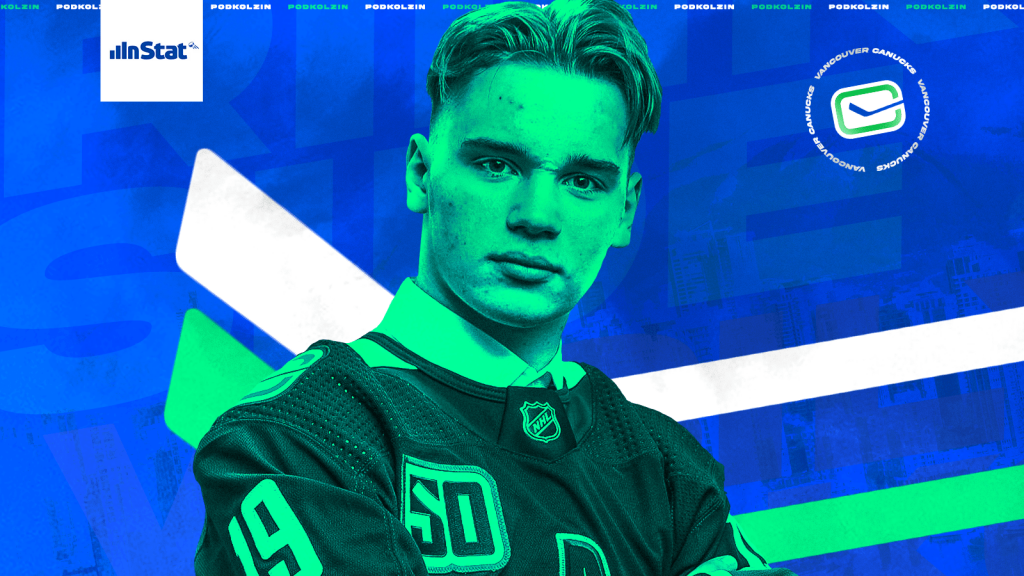No, it’s not the Time to Panic About Vasili Podkolzin

Just as concerns about Vasili Podkolzin’s early-season performance reached a feverish pitch, he offered Vancouver Canucks fans some chicken soup for their soul.
Podkolzin captained for Russia at the Karjala Cup, leading Russia’s under-20 team to three consecutive victories against senior teams — not bad!
It’s easy to forget that he closed out last season with 11 points in 17 games as one of SKA’s best players even in limited minutes. He appeared poised for an offensive breakout – and a larger offensive role. Instead, Podkolzin’s ice-time has steadily decreased throughout the season to 12 minutes, with just four points to show for it. But the point totals don’t do his performance justice – he’s performed admirably, especially defensively.
Podkolzin isn’t just capable defensively for a winger – he’s one of the best defensive forwards outside of the NHL. Without the puck nearby, most players stand upright and give their legs a rest. Podkolzin stays in athletic posture (he bends his knees), allowing him to immediately accelerate into a passing lane or closeouts on a potential shooter.
Unsurprisingly, that base leads to steal-after-steal on the back-check. Podkolzin hunts with such vigour that’s it’s shocking when he doesn’t pry the puck loose. Instead of lunging in, he takes the extra stride, before reaching across and checking their stick. By “cutting off the hands,” he frees up possession and creates an escape route.
It’s hard to find faults with Podkolzin’s defensive game that aren’t cherry-picked examples. He could be a bit more aggressive closing out on the point, as he’s a bit too much reliant on blocking the shot. Then again, it’s also common to see him get involved in three or four prior plays, cutting off the top, then playing the pass into the slot, engaging in a puck battle, before facing a closeout – players only have so much energy to expend.
Defence alone doesn’t make a top-six forward though. Thankfully, Podkolzin’s also one of the better playmakers among drafted prospects, with the potential to become so much better. Equally skilled on the backhand and forehand, he’s almost impossible to pressure into poor passes. When working up the boards in the offensive zone, he’s a deadly playmaker, handling the puck to mask his intentions before quickly firing a no-wind-up backhand pass into the slot.
In transition, Podkolzin hits the middle-lane driver, often with a bit of creativity on the delivery. He attacks inside opportunities, drawing the extra defender before firing a pass against the grain to an open teammate.
A general lack of deception hinders Podkolzin’s KHL playmaking, but when playing against the weaker competition – like the VHL or internationally – he adds more layers to his passes. Suddenly, he goes from skilled but predictable, to manipulative, especially on the power play. He layers look-offs onto full-body fakes onto against the grain slip passes – seriously high-level stuff. The elaborate misdirection pulls defenders and their sticks out of Podkolzin’s desired passing lane – even momentarily.
Tying the Podkolzin skill set together is an exceptional desire to play on the inside. Those defensive habits and physicality translate to the net-front, where Podkolzin puts intense pressure on the defence.
His battling isn’t mindless though. He frequently frees his stick timed with the play around him or backs off defenders to create an open passing lane.
In transition, Podkolzin has an admirable – but problematic (more on that soon) – willingness to drive the net. The outside-lane, straight-line solo dashes in transition that Podkolzin loves won’t translate to the NHL – the number of players with the speed, skill, and intelligence to consistently create on that play is single-digit. However, the constant desire to push plays to the middle from the corners and boards will translate – a unique skill that’s difficult to teach.
So, why can’t Podkolzin score in the KHL?
It’s tough to score without ice time. Podkolzin plays just 12:10 per game, while former linemates and fellow prospects Kirill Marchenko (a Columbus Blue Jackets prospect) and Ivan D. Morozov (a Vegas Golden Knights draft pick) have enjoyed expanded roles. There’s an easy explanation for this: Marchenko and Morozov have an additional season on their SKA contracts; Podkolzin’s expires at the end of this season. This, of course, ignores their superior play; even when Marchenko was Podkolzin’s linemate to start the season, he created more.
Before I anger Canucks fans, this doesn’t mean that Podkolzin’s usage is appropriate. He’s outplayed Joonas Kemppainen (16:59), Yevgeni Timkin (14:04), and Yakov Trenin (15:51) – the former two by healthy margins. If SKA St. Peterburg were indeed running a merit-based system, Podkolzin would be playing more – end of story.
While Podkolzin’s KHL woes start with deployment, they don’t finish there. For two seasons now, most of Podkolzin’s skills have been stuck in stasis.
Full credit, his skating has improved. Now, he pushes his knees over his toes, creating better depth in his stride and maximizing balance and leverage for puck protection. Inefficiencies remain, but he more frequently finishes his strides with ankle twist and toe push. However, Podkolzin’s handling, shooting, and creativity remain stuck at the same level they were in 2018-2019.
Much like skating mechanics, stick-handling form matters, too. Podkolzin has exceptional touch, deftly working the puck in-and-around defenders; however, he bases those moves on flawed mechanics that impact every part of his game. Ideally, a player:
- Allows their top hand/arm to move freely across the body, increasing range of control and allowing adjustment when the torso angle changes (i.e., when a defender leans on them);
- Rolls the puck “out the back” of the blade, maximizing blade on puck, blade on ice time, reducing exposure to defenders; and,
- Primarily handles the puck across the hips, rather than in front, allowing the player to transition into cuts toward the inside, shots, and passes seamlessly while reducing exposure to defenders.
Simply put, Podkolzin does the opposite of those three: he locks his top hand to his hip, lifts the entirety of his blade of the ice when handling (sometimes as high as foot), and almost exclusively keeps the puck out in front.
When Podkolzin receives a pass on the perimeter, he defaults to the attack along the perimeter in a straight line. With the puck exposed in front, Podkolzin runs out of space to cut to the inside as defenders close in, forcing him to outrace defenders along the perimeter. Against poor defenders, that results in the impressive but not translatable outside-lane net drive. In the KHL, it usually results in a low-percentage shot from the perimeter, a dump-in, or turnover. That’s why Podkolzin looks so involved but struggles to create.
Rather than skate in straight-lines, Podkolzin should start attacking on a curve towards the defender. With his puck across his hips, he’d threaten shot, pass, or carry in two directions (often called the triple threat stance). Remember that manipulative playmaking? The triple-threat stance is naturally deceptive, giving Podkolzin the advantage he needs to consistently set-up transition scoring chances.
The straight-line glide also houses Podkolzin’s primary shot set-up – which, well, isn’t ideal. Podkolzin comes down the wing, enters a glide, then winds up a wrister – it’s predictable, and once he starts gliding, he can’t adjust to new opportunities that open. Instead, he needs to start shooting in-stride, skipping the glide altogether. It catches goaltenders and defenders off guard. It would also maximize Podkolzin’s shooting skill, highlighted by blade deception built into every wrister and occasional curl-and-drag shots through pressure.
***
While those flaws might seem overwhelming – they aren’t. Podkolzin has the basis for NHL success. He’d step into the NHL with one of the league’s better physical games. Remarkable defensive impact gives him plenty of staying power in an NHL lineup. Few wingers have more desire to play up the middle – that’s much harder to teach than stick-handling mechanics and set-ups.
The skill development has started to pick up over the past month – Podkolzin’s started shooting in stride occasionally. As EliteProspects’ Editor-in-Chief J.D. Burke noted, he’s freeing up his top hand more while stick-handling. Those are promising signs. If the development continues through the World Juniors and the second-half of the season, expect Podkolzin to step into a top-nine role for the 2021-22 Vancouver Canucks with little friction.
Ultimately, skill development will decide if Podkolzin’s a bonafide top-line contributor or more of a 40-to-50-point threat in his prime. When accounting for his defensive impact, even the lower end of his offensive outcomes is a highly valuable player — one that surpasses the average 10th overall pick.
